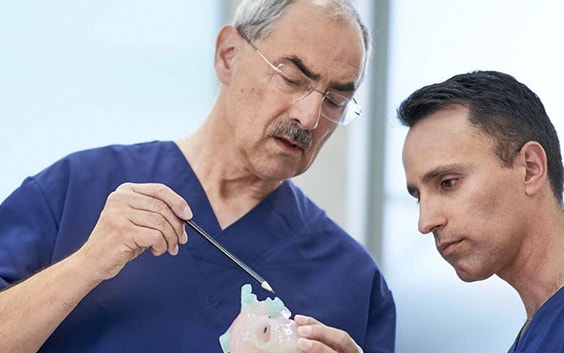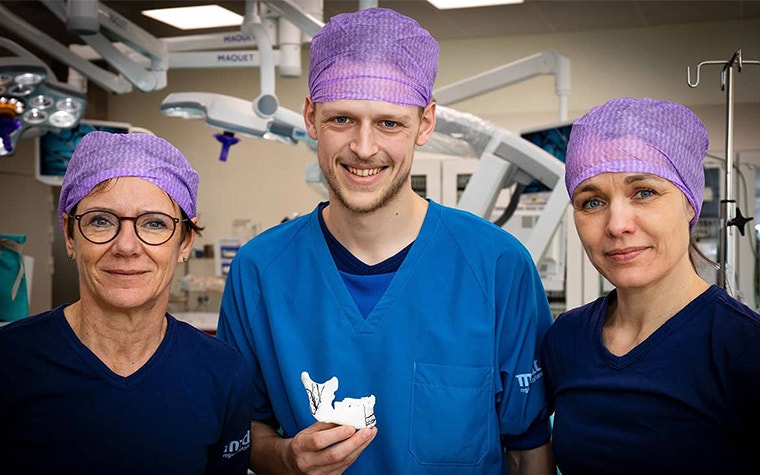EXPERT INSIGHT
3 Keys to Building a Sustainable 3D Printing Program in Your Hospital

3D technology has continued to transform healthcare over the past 20 years. It’s been used in multidisciplinary ways, from quick solutions during the pandemic to designing and producing personalized devices, planning complex clinical procedures, and training future medical professionals more effectively. Research trends predict that by 2021, 25% of surgeons will practice on 3D-printed models of the patient prior to the surgery. 3D printing and preoperative planning with 3D models are quickly becoming the new standard with clear patient, healthcare, and cost benefits.
In our 3D printing in medicine webinar, medical professionals from leading hospitals in the Nordic region presented how they successfully built 3D printing programs in their hospitals. Here, we present the three keys from their experiences to help you start and scale up a successful and sustainable 3D printing program in your own hospital.
1. Start small and build from collaboration
“Listening to the customer’s needs is an important basis for our strategy — continuous dialogue and feedback give way to new practical ideas. ”
— Irina Rinta-Kiikka, Head of Department of Medical Imaging, Tampere University Hospital, Finland
Throughout the webinar, almost every speaker mentions the importance of collaboration between the different teams. As Dr. Irina Rinta-Kiikka, Head of the Department of Medical Imaging at the Tampere University Hospital in Finland, says, “Listening to the customer’s needs is an important basis for our strategy — continuous dialogue and feedback give way to new practical ideas. Time used for this dialogue is valuable and a significant part of the work.”
Her colleague, Dr. Antti Lehtinen, Specialist in Dento-Maxillofacial Radiology, adds, “While considering the task at hand, you need to consider your own team and expand the team with the expertise you need for the current operation. It's crucial that you have the teamwork of the right specialists who know what they're doing. And that is the key to the best outcome.” In this way, the team forms organically from actual needs in the hospital and becomes a collaborative partner in defining new innovative approaches across different fields.
Another important factor in collaboration is just simple proximity, as Joakim Lundtoft Lindhardt, Head of the 3D Printing Center at Aarhus University Hospital in Denmark, explains: “It is key to be close to the reality that we are developing for. This means that if you are considering starting a 3D printing lab, you really have to be within close proximity of the clinic. And if you are based in a hospital, you have a unique opportunity to facilitate a close dialogue with team members, as Irina mentioned.” With dialogue that is more easily facilitated, there are more opportunities to continue working closely together.
2. Start with the correct setup
Joakim also suggests starting with a dedicated person, like he was for Aarhus University Hospital, who can handle the 3D technology and become the bridge between the lab and the hospital. As the need arises, the team can grow into a larger team of specialists to meet clinical demands. By having the right people from the start in your 3D lab, surgeons will benefit from better planning and preparation, despite their imperfect knowledge in 3D programs. All while saving time.
Joakim clarifies, “So now that we have high usage collectively, we can then utilize the software and the 3D printers at a much higher rate than we would if every department had to gain their own knowledge and purchase their own software and 3D printers. We are a team dedicated solely to 3D printing throughout our workday, and we like to say that, eventually, you become quite good at it. This is in contrast to my clinical colleagues, who have their schedules filled with surgeries, leaving very little time to gain knowledge of 3D printing. Therefore, we found this split of expertise — the 3D printing experts and the surgical — the most optimal. We can bring both together through fruitful collaboration.”
Additionally, Mr. Lindhardt and his team at the lab were initially interested in building their own software but quickly realized that the Materialise software was specialized and appropriate for their needs. The software is a registered medical device, which is a requirement for hospitals. Today, they use Mimics, Mimics InPrint, PROPLAN CMF, and 3-matic for 90% of what they do for the ten departments in the hospital and receive day-to-day assistance with design issues from the Materialise team.
3. Don't just tell them, show them
To receive and retain funding to build and expand your 3D printing program, speakers from the webinar advocate showing the administration:
- tangible prints
- time saved in the OR
- research outcomes showing potential patient benefits
- increased precision in surgery
- simplified quality control of surgical outcomes
- standardization of workflows
In addition, many of the speakers mention great opportunities for education using both Mimics InPrint for 3D prints and the Mimics Viewer, which allows interactive viewing of and feedback on 3D patient models, planning, and device designs.


In fact, Daniel Danielsson, Head of Patient Flow of Cranio-Facial Diseases at Karolinska University Hospital in Sweden, was hesitant to say that time is always saved in the OR because the clarity from the 3D planning often alerted the team to other issues that they didn’t know the patient had. He explains, “The precision is excellent, and the 3D resolution has outstanding detail for when you do your surgical planning. I could decrease operating time, which might be the case for the individual patient, but given what we can actually see now from a 3D perspective, you see so much more that you need to correct. The patient outcome quality increases.”
With the experienced benefits, including improved quality in patient care and cost savings, Nordic hospitals in the webinar saw the clear advantages of having an in-house 3D printing program and have chosen to expand their programs. We can conclude from this webinar that medical 3D printing in healthcare is not just a trend but is becoming the new standard for patient treatment.
L-101622-02
Share on:
You might also like
Never miss a story like this. Get curated content delivered straight to your inbox.
